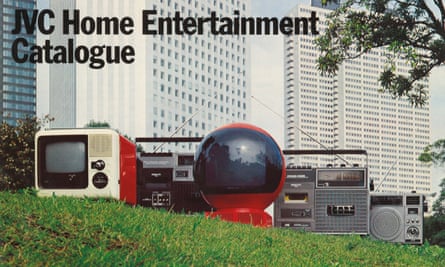This month’s design news is pretty nostalgic. Jonny Trunk’s wonderful history of hi-fi catalogues reminds us of the world before downloads and the relaunch of boutique Granny Takes a Trip brings back 60s psychedelia. And, as the new exhibition at Vitra Museum shows, looking to the past for answers to modern problems may well be the best solution.
The best design comes to Milan

April sees the annual design fest of Salone Del Mobile, Milano, the Italian trade show that brings the design world’s biggest brands together. This edition focuses on kitchen and bathroom design – with a special focus on technology that will change the future of cooking.
There’ll be an exhibition co-curated by six international food magazines and featuring artists, designers and chefs who will explore the cultural significance of food. Contributing publications include Italian gastronomy magazine L’Integrale, British title the Linseed Journal and the Portuguese art/food platform Farta. Another highly anticipated event at the Salone is the installation “A Thinking Room” by film-maker David Lynch. He has previous experience of this world since he designed and made furniture for his 1997 film Lost Highway, and presented a collection at Milan the same year. Lynch has released some advance plans of the installation and don’t worry – it does include blue velvet.
Salone Del Mobile Milano runs 16-21 April. Go to the website for more information
Granny Has a Flashback

Cult London boutique Granny Takes A Trip was founded in 1966 by artist Nigel Waymouth, Sheila Cohen, who collected Victoriana, and Savile Row trained tailor John Pearse. When it opened in the scruffy World’s End area of Chelsea, it was the pioneer in an area that would become the fashion centre of the 1960s counterculture. Even then, the shop sold mainly antique clothing and one-off designs made from vintage fabric found in markets.
The art nouveau inspired looks and vivid clothes were worn by the Beatles, Jimi Hendrix and Brigitte Bardot. These cultural figures didn’t just buy outfits at the shop, they also hung out at Granny Take A Trip, it was a place to learn and swap ideas as well as buy the dandy styles of the day. The shopfront was regularly reimagined by Waymouth featuring variously images of Native Americans, a portrait of Jean Harlow and, once, a car positioned as if it had crashed through the shop window.
The original boutique shut in 1979 – after a glam rock phase and a change of address – but it is being relaunched next month as an online boutique. In the spirit of the original, clothes will be made from repurposed upholstery fabric and surplus band merchandise. There’ll be a vintage clothes range and a rental service too.
Granny Takes a Trip relaunches online in April
The future of energy

The Design Council has just released the Green Design Skills Gap Report, which looks at how well equipped designers are to tackle the climate crisis. Only 43% of designers say they feel fully equipped to meet the demand for environmental design. So, it feels like the right moment for Transform! Designing the Future of Energy, the new exhibition at the Vitra Design Museum. This show looks at solutions to help reduce energy consumption and make lifestyle changes. Transform! features sections which look at human potential for energy generation, displays of technology to let you live off-grid and architectural solutions.
There are historic projects such as Charles and Ray Eames solar Do-Nothing Machine, which uses photovoltaic technology to set a kinetic sculpture in motion, cutting-edge tech such as Swiss MA student Stefan Troendle’s hydrogen cooker and a reexamination of traditional tech for modern life. The Day After House by Spanish architecture studio Takk improves energy consumption in existing buildings by using space to create climatic zones and natural insulation so effectively that the apartment needs no heating. When the design was first unveiled in 2022, Alejandro Muiño of Takk told Dezeen: “In the past, rooms used to be bigger because they were communal and easier to heat. We want to recover this knowledge that was forgotten due to the emergence of cheap energy.”
As the true cost of excessive energy consumption becomes clear, more designers will have to look for new ways to transform.
Transform! Designing the Future of Energy is at Vitra Design Museum until 1 September
after newsletter promotion
Watches good enough to eat

The first British Watchmakers Day (BWD) took place this month – a sold-out exhibition for members of the Alliance of British Watch & Clock Makers to showcase their timepieces to an enthusiastic audience. Among the collectors and horologists, a man in the chef’s hat and apron taking orders for pizza seemed a little out of place but, within the industry, Studio Underdog and its range of food-themed watches have become a thing. After success with the Watermelon, the Pink Lemonade and the Mint Choc Chip watches, the company announced they were making a Pepperoni pizza special edition as a joke on 1 April 2023.
After their website received 20,000 new visitors and 800 sales inquiries, Studio Underdog realised their April fool joke was actually their latest hit timepiece. They decided to honour the sales queries with the caveat that buyers had to come and collect their pizza watches in person at trade shows. In this way, they could hand deliver them to customers in pizza boxes. At BWD, the brand’s most popular timepiece was the Pepperoni pizza watch, followed by a Hawaiian pizza edition. “I’ve never experienced anything like that,” said founder Richard Benc. “I wasn’t sure what people wanted to see. But it was clearly pizza watches.”
Studio Underdog’s next pizza watch event is the Windup Watch Fair, San Francisco
Adventures in stereo

As the founder of Truck Records, an eclectic label known for cult film music, electronica and experimental jazz, it is perhaps unsurprising that writer and broadcaster Jonny Trunk has a fascination with hi-fi. But his new book Audio Erotica showcases an under-appreciated part of the home listening market’s history. This book chronicles hi-fi catalogues, providing a feast of forgotten formats, technical illustration, aspirational art direction and a social history of the changing audience for home listening.
Audio Erotica shows how manufacturers reacted to the popularity of pop music and house parties and the invention of cassettes and CDs. Alongside archives from industry greats such as Sony, Phillips and Bang & Olufsen, you can learn about the hi-fi companies that have not fared so well – Black Magic, Pickering and Nova, anyone? Not only are the catalogues great to look at but Trunk’s captions are funny and informative. Pick this up for the Athena-esuqe models in the Sony ads, read it cover to cover for the arcane facts about styluses, cassette recorders and walkmen.
Audio Erotica: Hi-Fi Brochures 1950s-1980s by Jonny Trunk (Fuel books) is out now
Chanel’s art stars

French fashion house Chanel recognises the value of design in all things, not just a well-cut suit. The Next Prize is a bursary and mentoring programme overseen by Chanel’s Culture Fund. This award selects 10 contemporary artists who are pushing boundaries in their respective creative fields. The latest winners have just been announced, and come from the UK, US, Ireland, Brazil, Singapore and Georgia. They work across film, dance, video game design, opera and digital art.
Self-taught game developer Sam Eng is one of the winners. He independently launched his award-winning debut game on Nintendo Switch in 2018 and is now working on Skate Story, which features a skateboarding glass demon. Eng collaborates with digital artist Ian Cheng on installation pieces and has also found time to co-found Gumbo NYC, a collective for independent game makers.
Yana Peel, the global head of arts and culture at Chanel, said: “The Chanel Next Prize was founded to amplify the work of artists who are making a difference and redefining their disciplines. The second edition of the prize will celebrate and support 10 such artists. Each is a catalyst and a pioneer. Each is disrupting established practice across a multitude of cultural fields, from art and opera to cinema and game design. Watching their creative journeys will be thrilling.”
